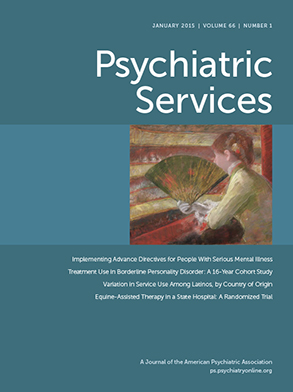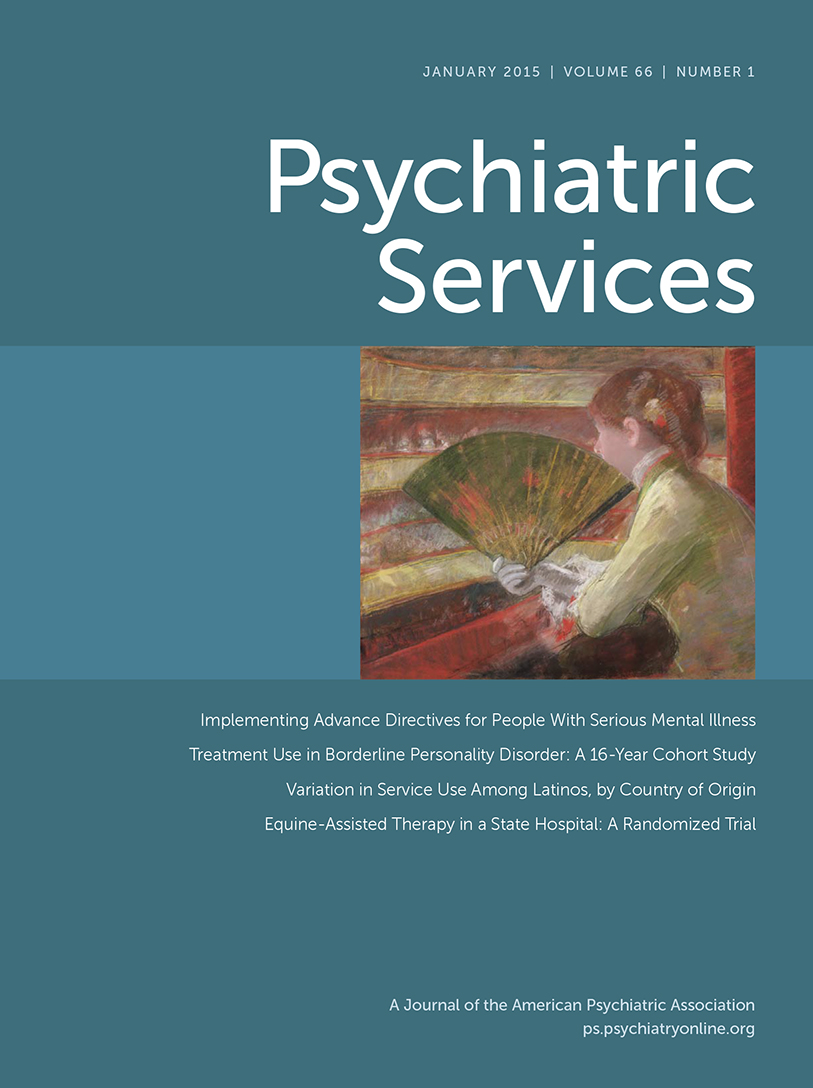A service dog is considered an assistive device on which patients with a physical or psychiatric disability rely to support their independence in day-to-day functioning. There are approximately 17,000 service dogs in the United States; a more accurate count is difficult because of the lack of a central training or certifying agency (
1). The Americans with Disabilities Act (ADA) established certain rights and responsibilities for individuals with disabilities and others whom they may encounter in public and government settings, including health care settings.
However, psychiatric hospitalization may pose a problem. It requires balancing the requirement to provide safe and appropriate psychiatric care with the rights and needs of individuals with disabilities. Despite the growing use and awareness of service dogs, only one 1995 article in a psychiatric journal has addressed this dilemma (
2). This Open Forum examines issues that arise when a service dog’s handler requires psychiatric hospitalization. It reviews the literature and provides a foundation for the development of policies and procedures.
Service Dogs
A service animal is defined by the ADA now as specifically any dog (with limited exceptions for miniature horses) that is “individually trained to do work or perform tasks for the benefit of an individual with a disability, including a physical, sensory, psychiatric, intellectual, or other mental disability” (
3). Any dog that meets the ADA’s definition is considered a service dog regardless of whether the dog has been licensed or certified. A service dog is not a pet, but differentiating the two can be difficult. The ADA prohibits the requirement of “certification” or proof of a dog’s training, and there is no legal requirement that a service dog wear identifying items (
4). The only way to know whether a dog is a service dog is to ask its handler.
Types of disabilities for which service dogs are used include but are not limited to blindness or visual impairments, deafness or hearing impairments, physical mobility issues, epilepsy, diabetes, and psychiatric disabilities. Tasks specific to psychiatric disabilities include reminding the handler to take medication, providing safety checks or room searches, turning on lights for a person with posttraumatic stress disorder or other anxiety disorder, interrupting self-mutilation, and keeping disoriented individuals from danger (
3,
5,
6). Of note, until further study provides clear evidence to support the efficacy of mental health service dogs, the Department of Veterans Affairs (VA) currently prevents the extension of service dog benefits if the dog is to be used to mitigate the effects of mental illness that are not related to visual, hearing, or mobility impairments (
7). Other types of service dogs in health care settings include emotional-support dogs, animal-assisted therapy dogs, and visitation dogs. Because these dogs do not perform tasks in support of the functioning of their handlers, they are not covered under the ADA.
The ADA and its Provisions
The ADA, passed by Congress in 1990 and last updated in 2010, was built on Section 504 of the Rehabilitation Act of 1973, which protected individuals with disabilities from entities owned or funded by the federal government. The ADA is an “equal opportunity” law that prohibits state and local governments and public entities from discriminating against individuals on the basis of disability, regardless of the type of disability or the assistive equipment the individuals might use (
5). An individual with a disability is defined by the ADA as a person who has a physical or mental impairment that substantially limits one or more major life activities, has a record of such an impairment, or is regarded as having such an impairment (
3).
Under the law, a person’s service dog must be allowed to accompany the person when he or she accesses public services and accommodations, even under conditions that would not normally allow pets or other animals. Service dogs may be excluded if access would cause an undue hardship or a “fundamental alteration”—that is, when a reasonable accommodation or modification would change the nature of the entity such that it no longer resembles the original nature of the business. Access can also be denied if the dog is thought to pose a direct threat to others; however, the risk must be significant and immediate and based on objective evidence and not fear and opinions (
4,
5). Service dogs may also be excluded when the animal is out of control and the handler does not take effective action to control it or when the animal is not housebroken (
3). However, as noted by Houghtalen and Doody (
2) in their 1995 article on this topic, the language of the law remains vague, and the law continues to lack clear definitions for phrases such as “public accommodation,” “fundamental alteration,” and “jeopardize the safe operation”—all of which are important when considering psychiatric hospitalization.
Service Dogs and Psychiatric Care
Although the number of patients with service dogs who require psychiatric hospitalization is not known, it is likely that a psychiatrist will at some point encounter this situation. Service dogs may pose a threat to basic objectives of psychiatric hospitalization. A patient’s risk to self or others is the most common indication for hospitalization (
8). However, if the fundamental nature of the inpatient psychiatric ward is to ensure the safety of all patients and provide a safe environment conducive to treatment and recovery (
9), then the disruption of this task by a service dog might constitute a “fundamental alteration” in the nature of the ward. Safety risks associated with service dogs on the inpatient ward include potential injury to others or to the service dog and relaxed safety protocols, such as the use of potentially lethal items, such as dog leashes, that would otherwise be prohibited. Treatment hazards arising from the presence of the animal include impaired patient integration into the milieu, staff counter-transference because of animal caretaking duties that may be required of them, and staff stress about financial and legal liability. Patient phobias, allergies, and the potential risk of zoonoses are also important considerations (
4). Alternatively, service dogs may be of benefit to the patient by providing disability assistance, offering a calming and comforting familiar object, maintaining routine and assuming responsibilities, and avoiding additional financial and psychological stress for the patient associated with finding a caretaker for the dog. Patients may also be more agreeable to admission, avoiding the need for less desirable involuntary admissions.
Houghtalen and Doody (
2) concluded that in their specific cases they were not compelled by statute to allow service dogs because they considered that the presence of a dog fundamentally altered the ward and its practice. However, they acknowledged that decisions should be determined on a case-by-case basis and that each unique factor must be weighed. They predicted that case law will eventually provide clearer guidance. Case law has since begun to rule against blanket policies that ban entry of service dogs to inpatient psychiatric facilities, even when policies are based on previous adverse outcomes and negative experiences (
10).
Recommendations and Suggested Guidelines
When evaluating a patient with a service dog, the first step is inquiry. The ADA permits two basic questions: “Is this animal required because of a disability?” and “What work or task has this animal been trained to perform?” Questions such as “What is your disability?” and “Do you have proof or identification for the animal?” are prohibited.
Once a patient is assessed to need hospitalization, decisions should be guided by likely scenarios that are based on the specific case at hand and that are not hypothetical, generalized cases. First, one should assess whether the patient wants or needs the service dog during the hospitalization. Next, one should determine whether it is necessary and appropriate for the dog to be admitted. Conceptually, it may be helpful to substitute the term “assistive device” for “service dog” in thinking through the issues. Access would be restricted for a patient who requires a cane if the patient has a history of using the cane violently. Likewise, a service dog on a leash may be inappropriate when a patient is reporting suicidal thoughts with a plan to hang himself. In both cases, the patient’s needs would have to be met in other ways.
Next, the milieu should be assessed for individuals who may be more vulnerable, such as older adults, young children, pregnant women, and immunocompromised individuals. Arrangements should be made to minimize exposure. Factors to consider are medical necessity; reasonable accommodations; and reasonable alternatives given nature of the facility, the unit, and the current patient population. If the patient but not the service animal is admitted, it should be clear who is responsible for coordinating animal care. A list of resources could be compiled to include local veterinarian services and any animal care services affiliated with the medical institution. It is not ideal—nor should it be expected—that hospital staff members should care for the service animal. Whatever the arrangement, legal services and risk management could be consulted for guidance and advice. Finally, the decision, along with any limitations and the process by which the clinician arrived at the decision, should be documented in the record and communicated to the patient.
Before a service animal is allowed on a psychiatric ward, the protocol should address whether a health assessment of the dog is required by a veterinarian or hospital infection control. For example, determining whether the animal’s vaccinations are current may be necessary, although it is not clear whether the ADA permits inquiry about vaccinations. Once the animal is on the ward, standard guidance for service animals on the unit should be clear and comprehensive and address factors that influence the care of all patients and staff, the milieu, and the care of the animal. Health care personnel and other patients should be educated about basic etiquette and hygiene regarding service dogs, such as the prohibition against petting or playing with the dog and the need to wash hands before and after contact with the dog. The protocol should delineate responsibility for property damage (the handler may be held responsible for damages) and should outline emergency response plans for injury to a patient by the dog or injury to the dog by a patient. The protocol should consider who will feed the dog, clean the dog and any messes, and perform day-to-day care, including walking and toileting. The ADA clearly indicates that the handler alone is responsible for care of the dog, although it is not clear how this would be applied in a hospital setting, where patients depend on others and have limited privileges. [A table highlighting these considerations is available in an online data supplement to this Open Forum.]

